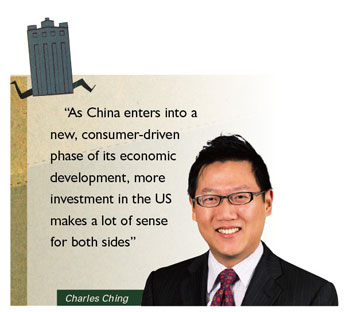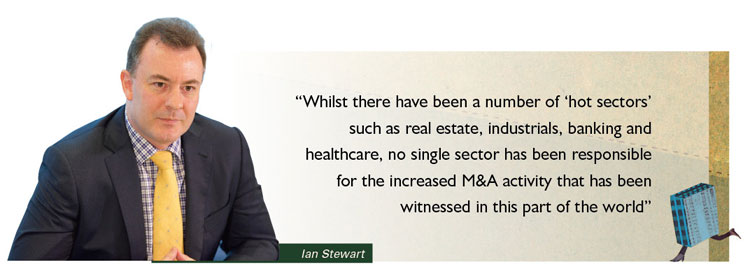With the aid of insight from some of the most reputable and in-the-know sources throughout the region, Chris Thomson sums up what has been and what potentially will be with regard to M&A’s in Asia and the Middle East.
Mergers and acquisitions throughout Asia and the MENA region, according to Dealogic, Wall Street Journal, saw a record-breaking US$367.7 billion in the first half of 2014, and, as was stated by Thomson Reuters, “the first nine months of 2014 grossed US$504.3 billion in value, a 59.1 percent increase over the US$317 billion recorded in the same period last year” in Asia (excluding Japan). The largest single contributor to this figure was CITIC Pacific’s acquisition of CITIC Ltd for US$42.2 billion, Asia-Pacific’s largest ever M&A deal, beating 2000’s previous holder – PCCW’s acquisition of Cable & Wireless HKT for US$35.5 billion.
While China may switch from being principally powered by coal to nuclear power, the ASEAN nations will be looking for ways to benefit from their upcoming integration. Japan’s lack of resources may see an increase in outbound activity, potentially heading in the direction of one of China’s now more relaxed sectors in the short term. However, longer term, investors may look inbound at infrastructure, hospitality and real estate due to the 2020 Tokyo Olympics being a source of revenue, which, after what has in the first three quarters been Japan’s “lowest year-to-date value in over a decade at US$19.9 billion, down 45.7 percent compared to the same time in 2013” according to Mergermarket, will be highly anticipated. China too may see more outbound investment, as stated by Charles Ching, corporate Partner at Freshfields, who commented “As China enters into a new, consumer-driven phase of its economic development, more investment in the US makes a lot of sense for both sides”.
The MENA region too has reason to anticipate growth in infrastructure, hospitality and real estate due to a worldwide event, with the FIFA World Cup set to be hosted in Qatar in 2022. Singapore saw plenty of outbound M&A activity in 2014 by government-backed institutions and, as was pointed out by Clyde & Co’s Singapore-based Partner Ian Stewart, historically, a fall in oil prices has led to increased investment activity in the energy sector, this trend looks set to continue into 2015.
 China’s sector segregation At the head of the queue for China’s big M&A news is the 6th version of the Foreign Direct Investment Industries Guidance Catelogue. Featuring a breakdown of who can own what, and how much of it they can own, the legislation categorises foreign involvement in certain industries ranging from ‘Encouraged’ to ‘Prohibited’, with ‘Permitted’ and ‘Restricted’ in between. This Catalogue was first seen in 1995, and the 2014 Draft replaced the 2011 version. The 2014 Draft was released on November 4 of this year, and the National Development and Reform Commission called for public opinion on it until December 3, 2014. Relevant sectors include manufacturing, pharmaceutical and medical, the auto industry, telecommunications and Internet, infrastructure and real property, education and the service sector. Between the introduction of the 2011 and 2014 Drafts came the Shanghai Free Trade Zone initiative, launched in September 2013. Many of the initiative’s regulations bypassed the 2011 Catalogue, as it adopted a Negative List. This list categorises foreign investment in certain sectors and included virtually all of the restrictions and prohibitions set out in 2011, disappointing a large group of foreign investors. It was then replaced by the 2014 Negative List in June 2014, which reduced the number of industries and activities that are ‘Restricted’ from 190 to 139. These restrictions have been relaxed even further by November’s 2014 Draft, which promises to more than half the number of ‘Restricted’ industrial sectors from 79 to 35, half the number of sectors requiring a Chinese majority shareholder from 44 to 22 and decrease the number of sectors limited to joint ventures and partnerships from 43 to 11. Giving his thoughts on this, Clyde & Co’s Shanghai-based Partner Michael Cripps stated that the general trend has been for sectors to become more lenient in terms of foreign permittance, and that a recurring feature the Catalogue is the reduction of the number of ‘Prohibited’ industry sectors. This does not include education, which remains far more stringent, as foreign investment in high school and day-care are ‘Restricted’, while compulsory education is ‘Prohibited’. Similarly, the manufacturing of auto vehicles is becoming increasingly more stringent, with it having gone from ‘Encouraged’ in 2007 to ‘Permitted’ in 2011, and in the new Draft, due to support domestic auto brands, the regulations have been tightened again to ‘Restricted’. |

|
What’s new in other jurisdictions
Similar to China’s 2014 Draft, the Saudi Arabian General Investment Authority (SAGIA), on October 25, 2014, introduced a programme that will monitor the impact of foreign investment in the Kingdom of Saudi Arabia (KSA). The programme will, as Clyde & Co’s MENA Head of Corporate Niall O’Toole informs, focus on six areas, namely: transfer and localisation of technological know-how; diversification of the Kingdom’s economy; increasing of exports and decreasing of imports; developing Saudi human resources; reinforcement of economic competitiveness and products (in both domestic and international markets); and balancing the development of different regions within the KSA.
O’Toole also informed that so far in the 2013/14 period, his team has worked on approximately 80 M&A transactions and 60 joint venture ones, which is a slight increase on the previous year. Giving insight into trends, O’Toole said that infrastructure, energy and manufacturing have been the stand-out sectors for joint ventures, while M&A’s have tended to focus on infrastructure, retail/consumer, TMT, energy, healthcare and manufacturing.
Meanwhile, Japan’s M&A activity, domestic and cross-border, inbound and outbound, has, according to Kenneth Smith, Managing Partner and Japan Area Leader at EY, stabilised at around 2,000 transactions annually, since hitting a peak of nearly 2,800 in 2006. Smith also revealed that 2006 “also saw a ten-year high of just over 15 trillion yen in deal value, with 2013 at 8.6 trillion and this year looking to be slightly shy of the 2013 figure”. He went on to state that while approximately 70 percent of the deal volume had been domestic, this traditionally accounted for only about 20 percent of the value. Discussing outbound deals, Smith revealed that since 2010, these have tended to be in the 20 percent range, with them running at 23 percent this year to date. “The outbound deals, however, have accounted for the lion’s share of the value, at 68 percent this year”, he said.
Stewart remarked that “The Singapore M&A market has seen significant growth over the past 12 months with deal flows increasing by apporoximately 30 percent on last year’s figures”. Giving evidence, Stewart revealed that “2014 has indeed been a big year in terms of M&A activity, driven in particular by major outbound acquisitions by Singapore government-backed institutions. For example, GIC Pte. Ltd recently agreed to acquire US industrial real estate group IndCor Properties from Blackstone Group LP for US$8.1 billion, making it one of the largest industrial real estate sales to be undertaken.
“Temasek Holdings Pte. Ltd has also undertaken significant acquisitions. Earlier this year it acquired a major stake in Hong Kong based beauty retailer AS Watson Co. for US$5.7 billion. Recent figures suggest that close to a third of the approximately US$59 billion spent on acquisitions by Singapore companies both domestically and overseas can be attributed to deals involving one of GIC or Temasek.”
 Private equity plus Andrew Finnemore Capon, Managing Director of China Partnerships, which provides M&A services to corporate and private equity clients, as well as CFO services and advice on equity financing in China and SE Asia, also gave his thoughts on M&A’s in the region. China Partnerships advises on a number of sectors, with a particular focus on financial services, natural resources, healthcare and wholesale and retail. According to Capon, “M&A in China during the last year has seen deal activity by value weighted towards the technology/Internet and financial services sectors. Domestic industry leaders Lenovo, Alibaba and Tencent, have used healthy balance sheets to complete multi-billion US$ deals at home and abroad. In the financial sector, most deals have been domestic, such as Anbang Insurance’s US$2 billion investment in China Merchants Bank. “In an as yet relatively small segment of financial services, where Internet meets finance, innovation is creating some interesting new businesses, of which two are Internet money market funds and ‘person to person’ (P2P) lending. The dynamic growth potential of Internet funds in China has already been demonstrated by Alibaba’s Yuebao (meaning leftover treasure) money market fund, which, due to attractive terms and competitive interest rates, started around seven percent versus bank deposit typical three percent rate, “disrupted” the banks and catapulted Yuebao to become one of the largest money market funds in the world, with some US$90 billion in assets.” Focussing on the financial sector in the MENA region, O’Toole said “Banks are still wary of lending. We expect to see more activity next year as the economy continues to recover. Politically, the private sector in the Middle East is robust, considering what it has had to handle in recent times. We are keen to see a return to relative stability in Iraq and Afghanistan, and we are excited about potential opportunities in Iran.” |
 Similarly, growth is anticipated in Singapore by Stewart, who claimed “Private equity firms are becoming far more interested in the Singapore market, looking to acquire investments in a stable environment with greater exposure to the large growth markets in the region such as Indonesia and China” when referencing inbound investment. Singapore has, in the opening three quarters of the year according to Mergermarket, “been the most targeted country [for M&A’s in South-East Asia] with US$17.3 billion-worth of transactions, up 5.3 percent by value from the same period in 2013 (US$16.4 billion)”. Giving further insight into China’s financial sector, Capon stated: “Perhaps more interesting in terms of business model is P2P lending. In the US, the UK and other countries, leading P2P firms have already made their mark as successful suppliers of loans to individuals and SMEs, the latter an area in general not yet well served by banks. In China, industry regulations for P2P are still a work in progress and P2P firms vary significantly in quality. One innovation seen among some P2P practitioners is the use of ‘big data’, where online information about a loan applicant gleaned from social networking, Internet commerce and other online sources, be it Alipay and WeChat in China or Facebook in the US, is used to help improve the credit decision making process on that individual or business. “Some of the larger P2P firms in China have already attracted well-known investors; Dianrong, known for the quality of its underwriting systems, received an investment from Sun Hung Kai for long-term strategic cooperation to develop the Hong Kong and mainland P2P market. Dianrong also announced in October 2014 an alliance with a regional bank, Suzhou Bank to build an online platform to intermediate loans from the public to SMEs in Jiangsu province.” On change in the healthcare sector in China, Cripps noted “The pharmaceutical and healthcare sectors in China face significant change. The 2014 Draft downgrades investment in certain healthcare products (such as multivitamins) blighted by overcapacity to ‘Restricted’ but encourages investment in narcotics and class A psychoactive drugs by categorising them as ‘Permitted’.” |
 There have, therefore, been specific sectors in China that, due to M&A’s being ‘Permitted’ or even ‘Encouraged’, have seen growth. Sectors seem to have less influence on investment in the MENA region, as O’Toole says “ Regardless of sectors, one trend we have seen is the willingness (on the part of both local family businesses and foreign multinationals) to review and refresh their existing structures in an effort to maximise the growth opportunities that exist in the region”. In line with this, on sectors in Singapore, Stewart said, “Whilst there have been a number of ‘hot sectors’ such as real estate, industrials, banking and healthcare, no single sector has been responsible for the increased M&A activity that has been witnessed in this part of the world”. He went on to say that “There are a number of factors feeding into this increase in activity. Firstly, Singapore companies have benefited in recent times from a far more stable financial and political environment when compared with the fluctuating fortunes of a number of their close neighbours. A desire to pursue greater growth than may be achievable in the domestic market and to diversify have also been relevant factors, along with the desire to gain greater exposure to major markets such as China.” 2015’s investment hotspots Giving insight into China’s production of power, Cripps also explained how, due to easy storage and the fact that it’s less detrimental to the environment, he expects to see nuclear power gain on coal as one of China’s emerging sources of power generation, leading to an increase in nuclear-based M&A activity. When asked about M&A’s between China and the US, Ching felt it necessary to cover healthcare, consumer fields and agriculture, stating that he felt that they would be the most dominant areas for US-China M&A deals in coming years. Ching also said “American companies have established brands and technology which appeal to Chinese companies that are looking to access the rising middle class in China’s domestic market”, noting that the most significant trend within Chinese-US investment is its increasing diversity. |
 Looking to Singapore’s M&A future, Stewart “anticipate[s] that [the current] upward trend will continue over the next 12 months with market conditions remaining stable. Industries which may see increased activity include the energy sector, which historically has shown increased M&A volumes during times of falling oil prices. And in the insurance space, we also anticipate greater deal flows as overseas insurers under financial pressure continue to shed non-core assets and increasing capital requirements for insurers in emerging economies encourage them to look to attract foreign capital.” On the future of the energy sector with regard to Japan’s M&A’s, Smith pointed out that “Resource poor Japan has been on a buying spree in the oil and gas, mining and related sectors”. In forecasts on other sectors and their influences, Smith also said: “Deal dynamics arising from the recent devaluing of the Japanese yen to the US dollar will certainly affect both deal frequency and values in the coming months. The larger companies will most undoubtedly continue to invest overseas, albeit more cautiously given that relative yen prices of those assets remains high. Smaller to mid-sized firms will have a more difficult time justifying to themselves and to their shareholders that the same asset overseas is now over 40 percent more expensive than it was 18 months ago. This would most likely spell further domestic M&A in the form of sector consolidation in a variety of industries. “The scenarios for the longer term will be challenging for a purely domestic player, but with some positive ups along the way. There is the persistent declining and aging population challenge, coupled with an extremely low level of immigration thereby hurting the demand for many products and services. The continuing reliance on increasingly expensive imported fossil fuels for almost all of its electric power generation has hurt domestic manufacturing. Somewhat offsetting these factors would be the 2020 Tokyo Olympics and the investments this will bring, in particular, infrastructure, hospitality and real estate.” Toyko, of course, is not the only jurisdiction anticipating a change in M&A activity due to a major sporting event, as Qatar is set to host the FIFA World Cup in 2022. Clyde & Co’s O’Toole, however, said that this is not the only infrastructure programme in place there, but that he expects to see social infrastructure sectors such as education, healthcare and transport also undergo steady growth in M&A activity, which in turn, he says, will increase demand for the provision of legal services. The forthcoming ASEAN integration is, perhaps even more so than China’s 2014 Draft, sure to be a game changer. 2015 will see Brunei Darussalam, Cambodia, Indonesia, the Lao PDR, Malaysia, Myanmar, the Philippines, Singapore, Thailand and Vietnam implement the ASEAN Trade in Goods Agreement and Agreement on Customs, enabling free trade amongst the nations. According to Capon, “The ASEAN countries are seeing an increasing share of global M&A volumes, as investors are attracted by the economic potential of the ASEAN Economic Community due 2015, with its 600 million inhabitants and with the promise of more connected markets and lower tariffs. We have seen a rise in inbound M&A, as foreign investors build their presence.” Giving examples, Capon cited that “Indonesia, despite uncertainty created by the general election in 2014, has proved to be one of the most attractive to investors: Japanese insurers have invested into local firms to gain exposure to the current low penetration rates and double digit premium growth prospects; Dai-ichi paid more than US$300 million for a 40 percent stake in Indonesia’s Panin Life. Regional M&A is also underway, to build stronger local champions to be better equipped for increased foreign competition, as in the case of Thailand Berli Jucker’s acquisition of German Metro’s cash and carry business in Vietnam for US$876 million.” Clearly, inbound and out, Asia and the MENA region, as stated by the sources above, should expect to see plenty of M&A activity over the coming year, due to new legislation, worldwide events and consolidation of markets, as well as its already strong financial sector. Different places will be targeted due to their natural resources; a sector that may see a shift due to environmental factors such as coal’s detrimental effect on the planet and the savings that can be made in storing nuclear power. China’s overall increased leniency towards foreign investment is sure to have an effect too. Time will tell the impact of the ASEAN integration, but considering the area’s resources and manpower, this development appears to be one that will unite and strengthen these currently separate jurisdictions, and may well be seen as a very alluring prospect to investors worldwide. As was said by American philosopher Amos Bronson Alcott, “That is a good book which is opened with expectation, and closed with delight and profit”. Let’s hope 2015 is one Alcott would define as a good year. |

















